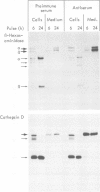Abstract
Polyclonal antibodies to the mannose 6-phosphate specific receptor from human liver inhibited the endocytosis of lysosomal enzymes in fibroblasts by greater than 95% and enhanced 3-20-fold the secretion of precursors of lysosomal enzymes in these cells. Exposing fibroblasts for 4 h to antibody resulted in loss of greater than 90% of the membrane-bound receptors. If fibroblasts were treated with the antibody in the presence of CBZ-Phe-Ala-CHN2, an inhibitor of lysosomal cysteine proteinases, the receptor and smaller degradation products are recovered in dense lysosomes. In treated cells 18-58% of total receptor-related polypeptides were recovered in dense lysosomes. In control cells less than 4% of the receptor was found in the lysosomal fraction. We conclude from these results that normally the receptor is spared from lysosomal degradation. When tagged with antibody, however, the receptor is transported into lysosomes and degraded. The loss of intracellular receptors involved in segregation of newly synthesized lysosomal enzymes indicates an exchange between the former and the plasma membrane-bound receptors.
Full text
PDF
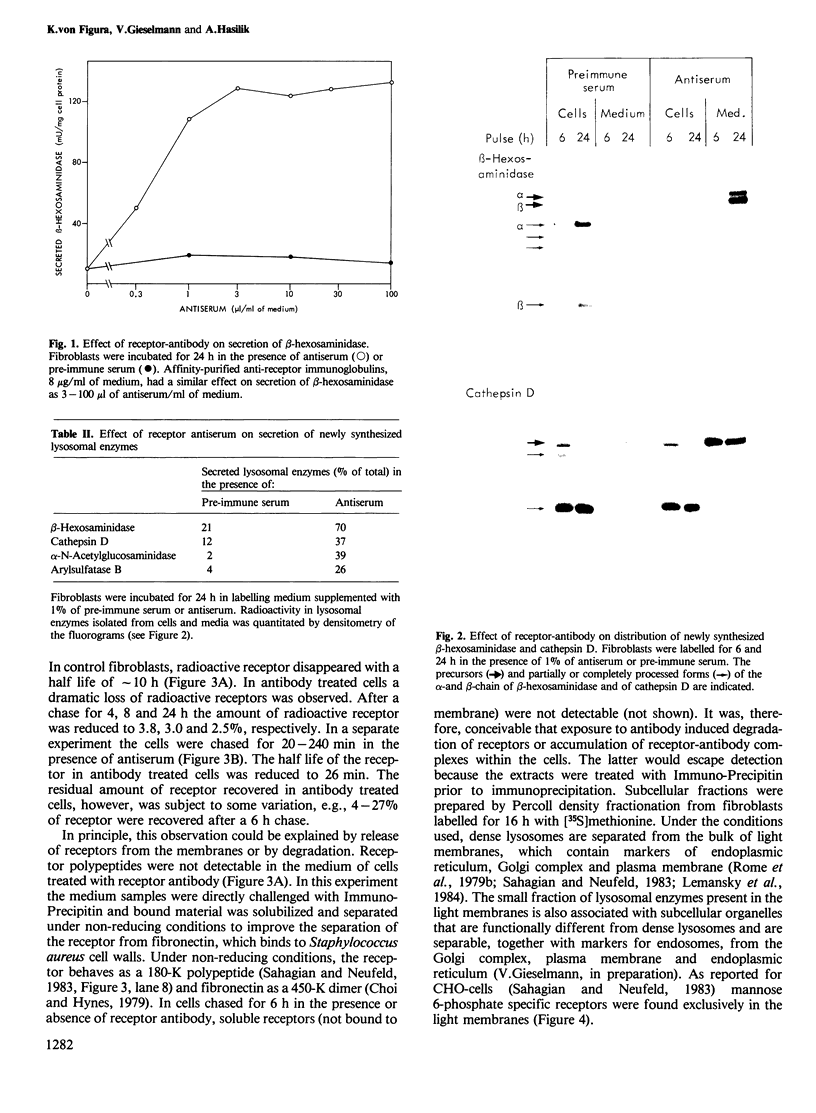
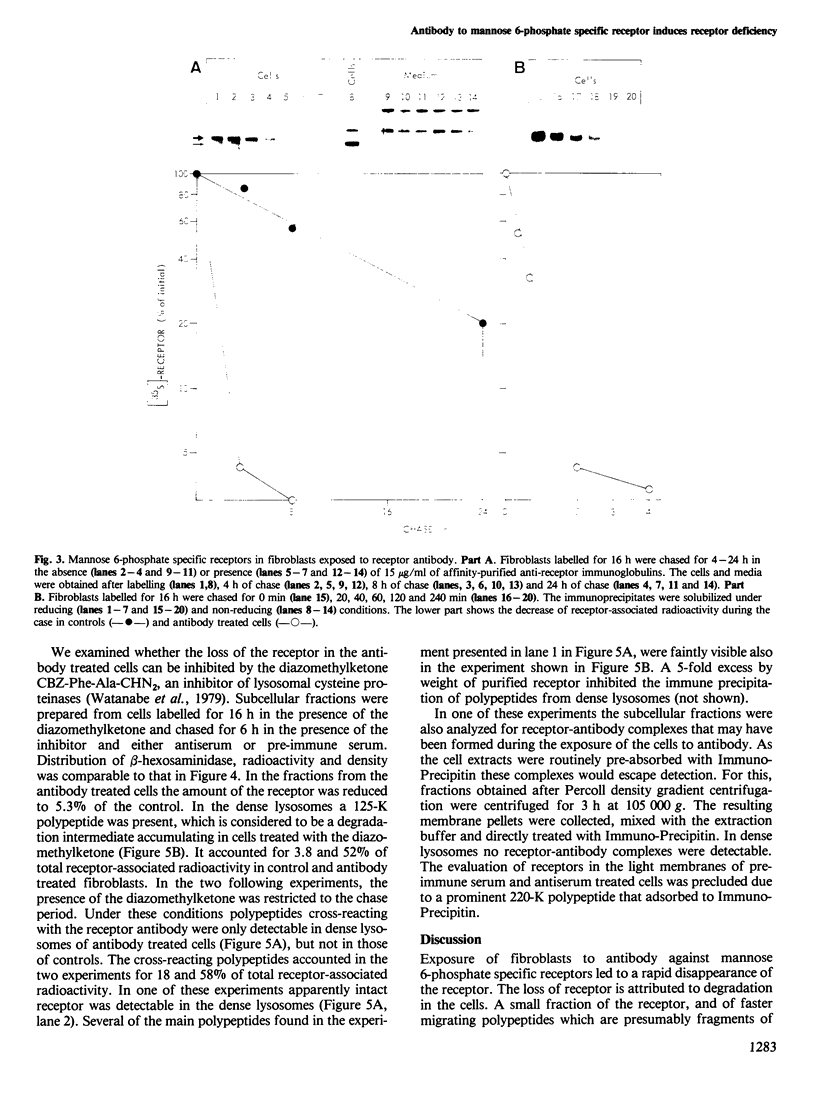
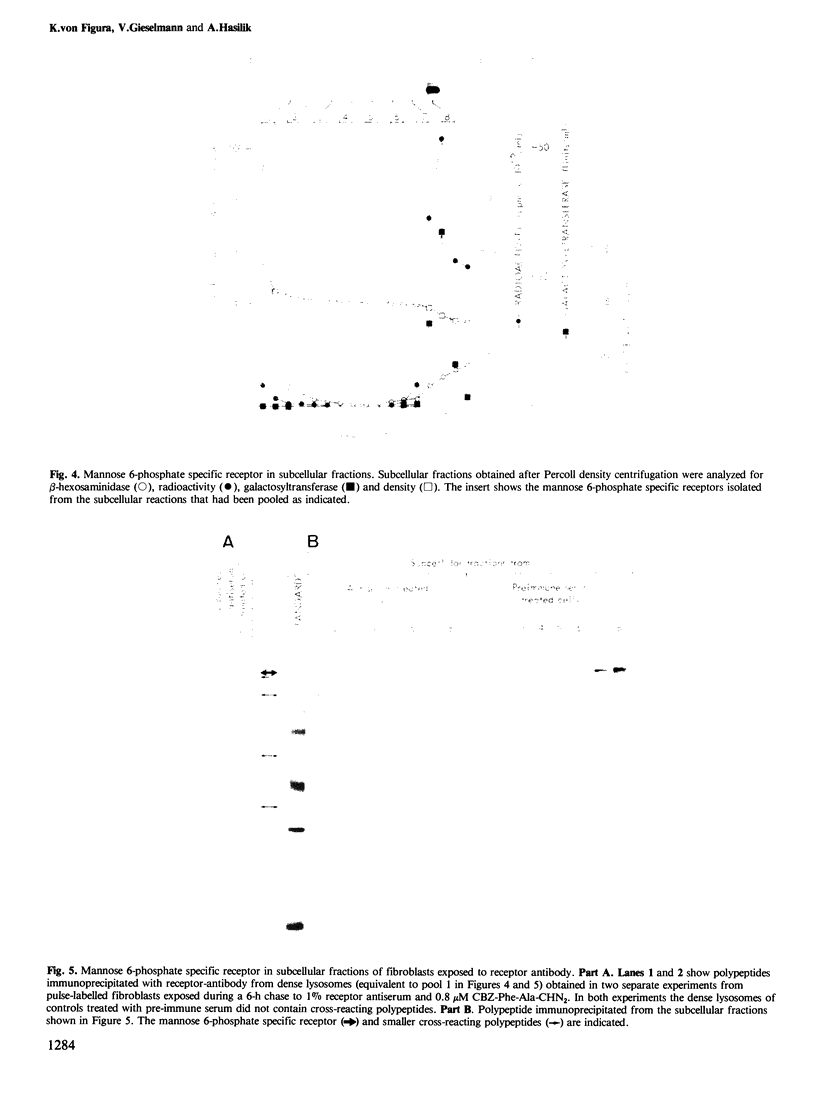
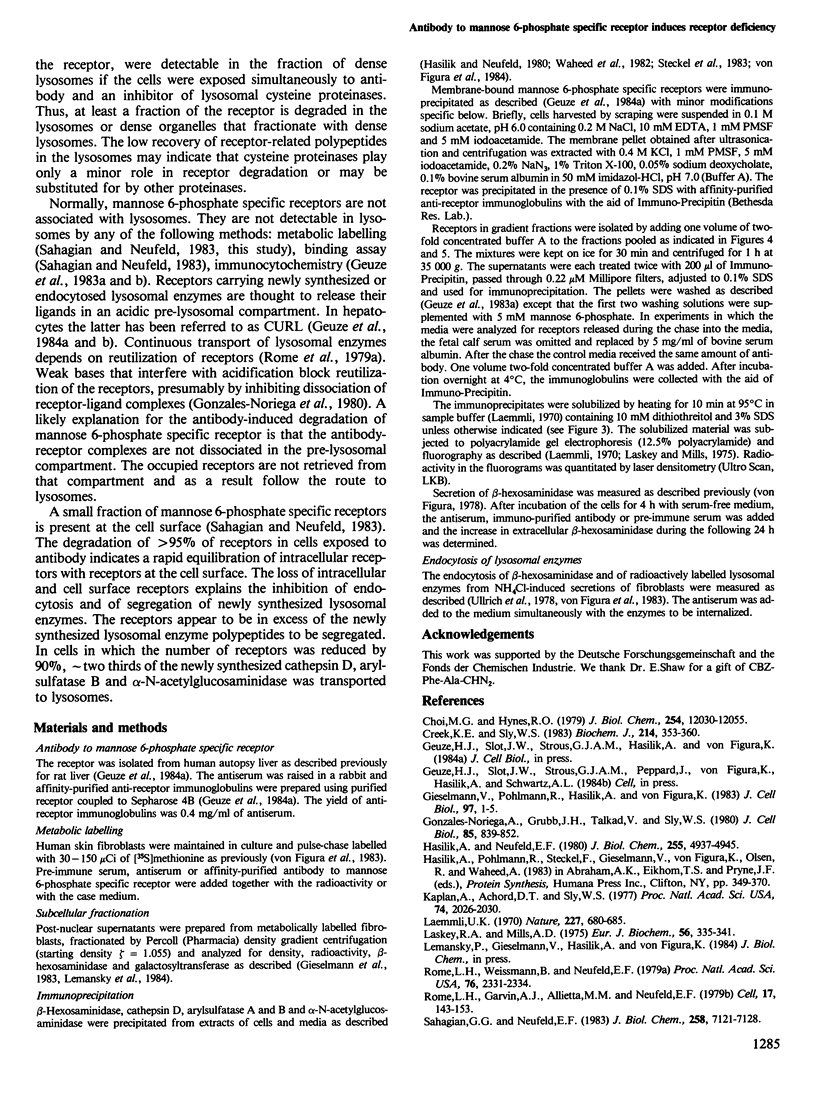

Images in this article
Selected References
These references are in PubMed. This may not be the complete list of references from this article.
- Choi M. G., Hynes R. O. Biosynthesis and processing of fibronectin in NIL.8 hamster cells. J Biol Chem. 1979 Dec 10;254(23):12050–12055. [PubMed] [Google Scholar]
- Creek K. E., Sly W. S. Biosynthesis and turnover of the phosphomannosyl receptor in human fibroblasts. Biochem J. 1983 Aug 15;214(2):353–360. doi: 10.1042/bj2140353. [DOI] [PMC free article] [PubMed] [Google Scholar]
- Gieselmann V., Pohlmann R., Hasilik A., Von Figura K. Biosynthesis and transport of cathepsin D in cultured human fibroblasts. J Cell Biol. 1983 Jul;97(1):1–5. doi: 10.1083/jcb.97.1.1. [DOI] [PMC free article] [PubMed] [Google Scholar]
- Gonzalez-Noriega A., Grubb J. H., Talkad V., Sly W. S. Chloroquine inhibits lysosomal enzyme pinocytosis and enhances lysosomal enzyme secretion by impairing receptor recycling. J Cell Biol. 1980 Jun;85(3):839–852. doi: 10.1083/jcb.85.3.839. [DOI] [PMC free article] [PubMed] [Google Scholar]
- Hasilik A., Neufeld E. F. Biosynthesis of lysosomal enzymes in fibroblasts. Synthesis as precursors of higher molecular weight. J Biol Chem. 1980 May 25;255(10):4937–4945. [PubMed] [Google Scholar]
- Kaplan A., Achord D. T., Sly W. S. Phosphohexosyl components of a lysosomal enzyme are recognized by pinocytosis receptors on human fibroblasts. Proc Natl Acad Sci U S A. 1977 May;74(5):2026–2030. doi: 10.1073/pnas.74.5.2026. [DOI] [PMC free article] [PubMed] [Google Scholar]
- Laemmli U. K. Cleavage of structural proteins during the assembly of the head of bacteriophage T4. Nature. 1970 Aug 15;227(5259):680–685. doi: 10.1038/227680a0. [DOI] [PubMed] [Google Scholar]
- Laskey R. A., Mills A. D. Quantitative film detection of 3H and 14C in polyacrylamide gels by fluorography. Eur J Biochem. 1975 Aug 15;56(2):335–341. doi: 10.1111/j.1432-1033.1975.tb02238.x. [DOI] [PubMed] [Google Scholar]
- Rome L. H., Garvin A. J., Allietta M. M., Neufeld E. F. Two species of lysosomal organelles in cultured human fibroblasts. Cell. 1979 May;17(1):143–153. doi: 10.1016/0092-8674(79)90302-7. [DOI] [PubMed] [Google Scholar]
- Rome L. H., Weissmann B., Neufeld E. F. Direct demonstration of binding of a lysosomal enzyme, alpha-L-iduronidase, to receptors on cultured fibroblasts. Proc Natl Acad Sci U S A. 1979 May;76(5):2331–2334. doi: 10.1073/pnas.76.5.2331. [DOI] [PMC free article] [PubMed] [Google Scholar]
- Sahagian G. G., Neufeld E. F. Biosynthesis and turnover of the mannose 6-phosphate receptor in cultured Chinese hamster ovary cells. J Biol Chem. 1983 Jun 10;258(11):7121–7128. [PubMed] [Google Scholar]
- Sly W. S., Fischer H. D. The phosphomannosyl recognition system for intracellular and intercellular transport of lysosomal enzymes. J Cell Biochem. 1982;18(1):67–85. doi: 10.1002/jcb.1982.240180107. [DOI] [PubMed] [Google Scholar]
- Steckel F., Hasilik A., von Figura K. Biosynthesis and maturation of arylsulfatase B in normal and mutant cultured human fibroblasts. J Biol Chem. 1983 Dec 10;258(23):14322–14326. [PubMed] [Google Scholar]
- Ullrich K., Mersmann G., Weber E., Von Figura K. Evidence for lysosomal enzyme recognition by human fibroblasts via a phosphorylated carbohydrate moiety. Biochem J. 1978 Mar 15;170(3):643–650. doi: 10.1042/bj1700643. [DOI] [PMC free article] [PubMed] [Google Scholar]
- Waheed A., Hasilik A., von Figura K. Synthesis and processing of arylsulfatase A in human skin fibroblasts. Hoppe Seylers Z Physiol Chem. 1982 Apr;363(4):425–430. doi: 10.1515/bchm2.1982.363.1.425. [DOI] [PubMed] [Google Scholar]
- Watanabe H., Green G. D., Shaw E. A comparison of the behavior of chymotrypsin and cathepsin B towards peptidyl diazomethyl ketones. Biochem Biophys Res Commun. 1979 Aug 28;89(4):1354–1360. doi: 10.1016/0006-291x(79)92158-2. [DOI] [PubMed] [Google Scholar]
- von Figura K., Hasilik A., Steckel F., van de Kamp J. Biosynthesis and maturation of alpha-N-acetylglucosaminidase in normal and Sanfilippo B-fibroblasts. Am J Hum Genet. 1984 Jan;36(1):93–100. [PMC free article] [PubMed] [Google Scholar]
- von Figura K. Secretion of beta-hexosaminidase by cultured human skin fibroblasts. Kinetics, effect of temperature, cell density, serum concentration and pH. Exp Cell Res. 1978 Jan;111(1):15–21. doi: 10.1016/0014-4827(78)90231-8. [DOI] [PubMed] [Google Scholar]
- von Figura K., Steckel F., Hasilik A. Juvenile and adult metachromatic leukodystrophy: partial restoration of arylsulfatase A (cerebroside sulfatase) activity by inhibitors of thiol proteinases. Proc Natl Acad Sci U S A. 1983 Oct;80(19):6066–6070. doi: 10.1073/pnas.80.19.6066. [DOI] [PMC free article] [PubMed] [Google Scholar]



